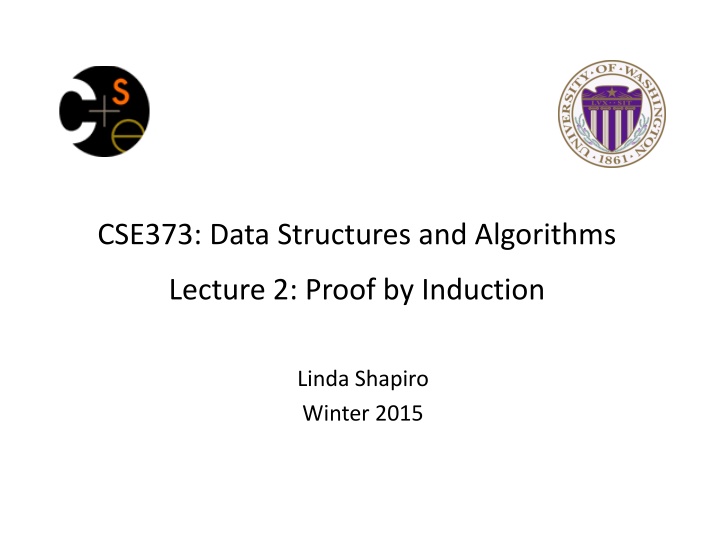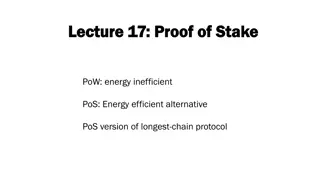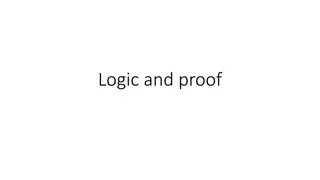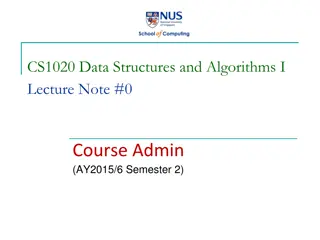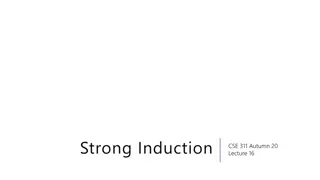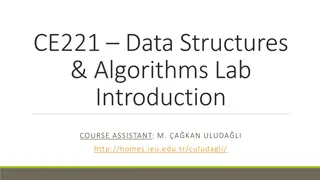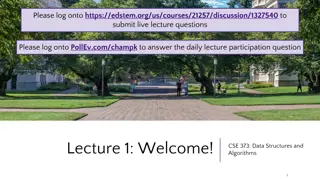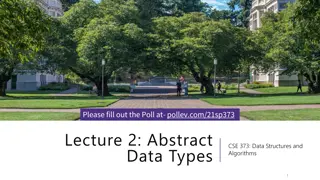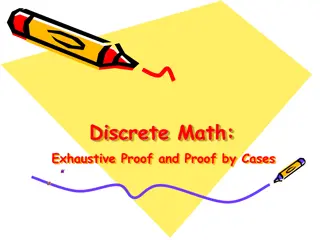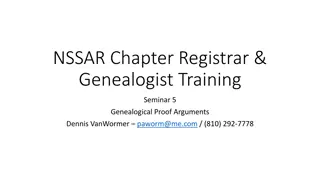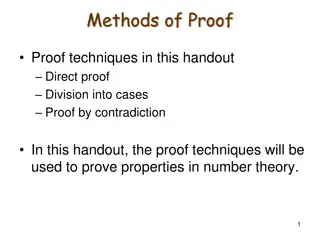Introduction to Proof by Induction in Data Structures and Algorithms
Explore the concept of proof by induction in the context of Data Structures and Algorithms. Understand the process of establishing a statement for all natural numbers using deductive steps, with examples and practical applications like AVL trees and heaps. Learn how to apply this technique to solve mathematical problems efficiently.
Download Presentation

Please find below an Image/Link to download the presentation.
The content on the website is provided AS IS for your information and personal use only. It may not be sold, licensed, or shared on other websites without obtaining consent from the author.If you encounter any issues during the download, it is possible that the publisher has removed the file from their server.
You are allowed to download the files provided on this website for personal or commercial use, subject to the condition that they are used lawfully. All files are the property of their respective owners.
The content on the website is provided AS IS for your information and personal use only. It may not be sold, licensed, or shared on other websites without obtaining consent from the author.
E N D
Presentation Transcript
CSE373: Data Structures and Algorithms Lecture 2: Proof by Induction Linda Shapiro Winter 2015
Background on Induction Type of mathematical proof Typically used to establish a given statement for all natural numbers (e.g. integers > 0) Proof is a sequence of deductive steps 1. Show the statement is true for the first number. 2. Show that if the statement is true for any one number, this implies the statement is true for the next number. 3. If so, we can infer that the statement is true for all numbers. Winter 2015 CSE 373: Data Structures & Algorithms 2
Think about climbing a ladder 1. Show you can get to the first rung (base case) 2. Show you can get between rungs (inductive step) 3. Now you can climb forever. Winter 2015 CSE 373: Data Structures & Algorithms 3
Why you should care Induction turns out to be a useful technique AVL trees Heaps Graph algorithms Can also prove things like 3n > n3for n 4 Exposure to rigorous thinking Winter 2015 CSE 373: Data Structures & Algorithms 4
Example problem Find the sum of the integers from 1 to n 1 + 2 + 3 + 4 + + (n-1) + n n i i=1 For any n 1 Could use brute force, but would be slow There s probably a clever shortcut Winter 2015 CSE 373: Data Structures & Algorithms 5
Finding the formula Shortcut will be some formula involving n Compare examples and look for patterns Not something I will ask you to do! Start with n = 10: 1 + 2 + 3 + 4 + 5 + 6 + 7 + 8 + 9 + 10 = ??? Large enough to be a pain to add up Worthwhile to find shortcut Winter 2015 CSE 373: Data Structures & Algorithms 6
Look for Patterns n = 1: 1 n = 2: 1 + 2 n = 3: 1 + 2 + 3 n = 4: 1 + 2 + 3 + 4 n = 5: 1 + 2 + 3 + 4 + 5 n = 6: 1 + 2 + 3 + 4 + 5 + 6 Someone solved this a long time ago. You probably learned it once in high school. Winter 2015 CSE 373: Data Structures & Algorithms 7
The general form We want something for any n 1 n(n+1) 2 Winter 2015 CSE 373: Data Structures & Algorithms 8
Are we done? The pattern seems pretty clear Is there any reason to think it changes? We want something for anyn 1 A mathematical approach is skeptical We must prove the formula works in all cases A rigorous proof Winter 2015 CSE 373: Data Structures & Algorithms 9
Proof by Induction Prove the formula works for all cases. Induction proofs have four components: 1. The thing you want to prove, e.g., sum of integers from 1 to n = n(n+1)/2 2. The base case (usually "let n = 1"), 3. The assumption step ( assume true for n = k") 4. The induction step ( now let n = k + 1"). n and k are just variables! Winter 2015 CSE 373: Data Structures & Algorithms 10
Proof by induction P(n) = sum of integers from 1 to n We need to do Base case Assumption Induction step prove for P(1) assume for P(k) show for P(k+1) n and k are just variables! Winter 2015 CSE 373: Data Structures & Algorithms 11
Proof by induction P(n) = sum of integers from 1 to n We need to do Base case Assumption Induction step prove for P(1) assume for P(k) show for P(k+1) 1 2 3 4 5 6 Winter 2015 CSE 373: Data Structures & Algorithms 12
Proof by induction What we are trying to prove: P(n) = n(n+1)/2 Base case P(1) = 1 1(1+1)/2 = 1(2)/2 = 1(1) = 1 Winter 2015 CSE 373: Data Structures & Algorithms 13
Proof by induction What we are trying to prove: P(n) = n(n+1)/2 Assume true for k: P(k) = k(k+1)/2 Induction step: Now consider P(k+1) = 1 + 2 + + k + (k+1) Winter 2015 CSE 373: Data Structures & Algorithms 14
Proof by induction What we are trying to prove: P(n) = n(n+1)/2 Assume true for k: P(k) = k(k+1)/2 Induction step: Now consider P(k+1) = 1 + 2 + + k + (k+1) = k(k+1)/2 + (k+1) Winter 2015 CSE 373: Data Structures & Algorithms 15
Proof by induction What we are trying to prove: P(n) = n(n+1)/2 Assume true for k: P(k) = k(k+1)/2 Induction step: Now consider P(k+1) = 1 + 2 + + k + (k+1) = k(k+1)/2 + (k+1) = k(k+1)/2 + 2(k+1)/2 Winter 2015 CSE 373: Data Structures & Algorithms 16
Proof by induction What we are trying to prove: P(n) = n(n+1)/2 Assume true for k: P(k) = k(k+1)/2 Induction step: Now consider P(k+1) = 1 + 2 + + k + (k+1) = k(k+1)/2 + (k+1) = k(k+1)/2 + 2(k+1)/2 = (k(k+1) + 2(k+1))/2 Winter 2015 CSE 373: Data Structures & Algorithms 17
Proof by induction What we are trying to prove: P(n) = n(n+1)/2 Assume true for k: P(k) = k(k+1)/2 Induction step: Now consider P(k+1) = 1 + 2 + + k + (k+1) = k(k+1)/2 + (k+1) = k(k+1)/2 + 2(k+1)/2 = (k+1)(k+2)/2 = (k(k+1) + 2(k+1))/2 Winter 2015 CSE 373: Data Structures & Algorithms 18
Proof by induction What we are trying to prove: P(n) = n(n+1)/2 Assume true for k: P(k) = k(k+1)/2 Induction step: Now consider P(k+1) = 1 + 2 + + k + (k+1) = k(k+1)/2 + (k+1) = k(k+1)/2 + 2(k+1)/2 = (k+1)(k+2)/2 = (k(k+1) + 2(k+1))/2 Winter 2015 CSE 373: Data Structures & Algorithms 19
Proof by induction What we are trying to prove: P(n) = n(n+1)/2 Assume true for k: P(k) = k(k+1)/2 Induction step: Now consider P(k+1) = 1 + 2 + + k + (k+1) = k(k+1)/2 + (k+1) = k(k+1)/2 + 2(k+1)/2 = (k+1)(k+2)/2 = (k+1)((k+1)+1)/2 = (k(k+1) + 2(k+1))/2 Winter 2015 CSE 373: Data Structures & Algorithms 20
Proof by induction What we are trying to prove: P(n) = n(n+1)/2 Assume true for k: P(k) = k(k+1)/2 Induction step: Now consider P(k+1) = 1 + 2 + + k + (k+1) = k(k+1)/2 + (k+1) = k(k+1)/2 + 2(k+1)/2 = (k+1)(k+2)/2 = (k+1)((k+1)+1)/2 = (k(k+1) + 2(k+1))/2 Winter 2015 CSE 373: Data Structures & Algorithms 21
Were done! P(n) = sum of integers from 1 to n We have shown Base case Assumption Induction step proved for P(1) assumed for P(k) proved for P(k+1) Success: we have proved that P(n) is true for any integer n 1 Winter 2015 CSE 373: Data Structures & Algorithms 22
Another one to try What is the sum of the first n powers of 2? 20 + 21 + 22 + ... + 2n k = 1: 20 = 1 k = 2: 20 + 21 = 1 + 2 = 3 k = 3: 20 + 21 + 22 = 1 + 2 + 4 = 7 k = 4: 20 + 21 + 22 + 23 = 1 + 2 + 4 + 8 = 15 For general n, the sum is 2n - 1 Winter 2015 CSE 373: Data Structures & Algorithms 23
How to prove it P(n)= the sum of the first n powers of 2 (starting at 0) is 2n-1 Theorem: P(n) holds for all n 1 Proof: By induction on n Base case: n=1. Sum of first 1 power of 2 is 20 , which equals 1 = 21 - 1. Inductive case: Assume the sum of the first k powers of 2 is 2k-1 Show the sum of the first (k+1) powers of 2 is 2k+1-1 CSE 373: Data Structures & Winter 2015 24 Algorithms
How to prove it The sum of the first k+1 powers of 2 is 20 + 21 + 22 + ... + 2(k-1) +2k sum of the first k powers of 2 by inductive hypothesis = 2k - 1 +2k = 2(2k) -1 = 2k+1 - 1 Winter 2015 CSE 373: Data Structures & Algorithms 25
End of Inductive Proofs! Winter 2015 CSE 373: Data Structures & Algorithms 26
Conclusion Mathematical induction is a technique for proving something is true for all integers starting from a small one, usually 0 or 1. A proof consists of three parts: 1. Prove it for the base case. 2. Assume it for some integer k. 3. With that assumption, show it holds for k+1 It can be used for complexity and correctness analyses. Winter 2015 CSE 373: Data Structures & Algorithms 27
